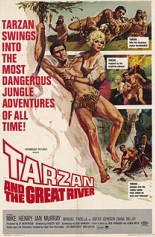
 Tarzan and the Valley of Gold wasn’t the last Tarzan movie to be influenced by the ’60s James Bond phenomenon. Coming two years later, the series’ next entry, Tarzan and the Great River, also stars Mike Henry and opens with a groovy spy feel, but adds The African Queen and Apocalypse Now to its mix. The latter wouldn’t come along for another 12 years, so it’s probably more accurate to cite Joseph Conrad’s Heart of Darkness.
Tarzan and the Valley of Gold wasn’t the last Tarzan movie to be influenced by the ’60s James Bond phenomenon. Coming two years later, the series’ next entry, Tarzan and the Great River, also stars Mike Henry and opens with a groovy spy feel, but adds The African Queen and Apocalypse Now to its mix. The latter wouldn’t come along for another 12 years, so it’s probably more accurate to cite Joseph Conrad’s Heart of Darkness.
Either way, Tarzan takes a trip up a mysterious river to confront the mad, god-like ruler of a deadly cult. His ride is on a boat owned by Charlie Allnut-lookalike Sam Bishop (comedian Jan Murray) and his boy sidekick Pepe (Manuel Padilla Jr., who was also in Valley of Gold, but as a different character). There’s also a nurse (Diana Millay from TV’s Dark Shadows) who’s trying to get some medicine to a remote village that’s under attack by a jaguar cult and its leader, Barcuna (Olympic decathlon champion Rafer Johnson).
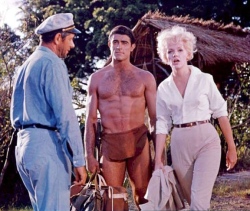 The Great River isn’t as over-the-top and sexy as Valley of Gold, but that’s what makes it so endearing. It has a different feel from its predecessor, mostly focused on the relationships between the travelers and their various reasons for going up river. There’s a great final battle between Tarzan and Barcuna, but what sticks with you is the movie’s humor and charm.
The Great River isn’t as over-the-top and sexy as Valley of Gold, but that’s what makes it so endearing. It has a different feel from its predecessor, mostly focused on the relationships between the travelers and their various reasons for going up river. There’s a great final battle between Tarzan and Barcuna, but what sticks with you is the movie’s humor and charm.
Boys may sleep with Valley of Gold, but they marry Great River. —Michael May

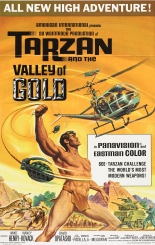
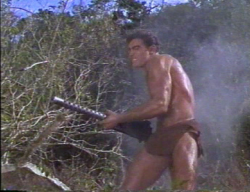
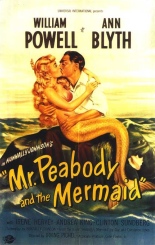
 Anyone going to
Anyone going to 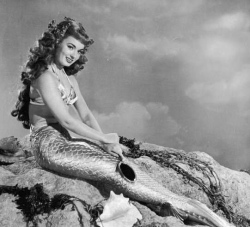 When he accidentally snags a mermaid (Ann Blyth) while fishing, he kidnaps her and takes her back to live in his lavishly deep fish pond right under his wife’s nose. Polly suspects something’s up, but she thinks he’s having an affair with a local hussy. Not that Polly has a lot of moral ground to stand on, since she’s been having secret lunches with the village cad.
When he accidentally snags a mermaid (Ann Blyth) while fishing, he kidnaps her and takes her back to live in his lavishly deep fish pond right under his wife’s nose. Polly suspects something’s up, but she thinks he’s having an affair with a local hussy. Not that Polly has a lot of moral ground to stand on, since she’s been having secret lunches with the village cad.
 I’m as surprised as anyone to learn that there are levels of “quality” to the movies Syfy plays, but compared to the kind of stuff Syfy usually presents,
I’m as surprised as anyone to learn that there are levels of “quality” to the movies Syfy plays, but compared to the kind of stuff Syfy usually presents, 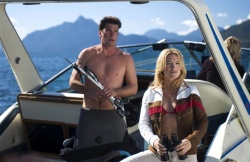 Something else it has going for it are the leads. Maybe I’m just still in love with her from
Something else it has going for it are the leads. Maybe I’m just still in love with her from 
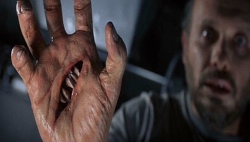 Leviathan does have some significant, although superficial-to-the-story differences from Alien, however. H.R. Giger famously designed the creature in Alien; Leviathan’s beast was created by the great Stan Winston, who unfortunately wasn’t doing his best work here. The early stages of the monster look cool, like a killer eel or something, but as it matures, it turns into an asymmetrical version of the Creature from the Black Lagoon-type character from
Leviathan does have some significant, although superficial-to-the-story differences from Alien, however. H.R. Giger famously designed the creature in Alien; Leviathan’s beast was created by the great Stan Winston, who unfortunately wasn’t doing his best work here. The early stages of the monster look cool, like a killer eel or something, but as it matures, it turns into an asymmetrical version of the Creature from the Black Lagoon-type character from